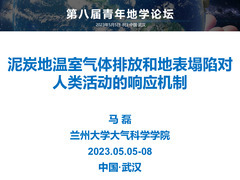报告详情
Anthropogenic activities and their impacts on greenhouse gases releases and land subsidence from peatlands
编号:3443
访问权限:私有
更新:2023-05-06 22:26:21
浏览:612次
口头报告
摘要
Peatland ecosystems are globally important carbon stores. Disturbances, such as drainage and climate drying, act to lower peatland water table depths, consequently enhancing soil organic matter decomposition, mineralization and subsidence rates. Using our own annually measured fluxes of greenhouse gases (GHGs) and globally synthesized annual GHGs from peatlands, we find that the water table decline (due to anthropogenic drainage or climate drying) significantly reduces net CO2 uptake across Tibetan peatlands to global peatlands, while substantially increases N2O emissions. We also find that the water table decline stimulated heterotrophic, rather than autotrophic, soil respiration, which was associated with an increase in subsidence rate. This relationship held across different climate zones and land uses. We find that 81% of the total annual soil respiration for all drained peatlands was attributable to tropical peatlands drained for agriculture and forestry and temperate peatlands drained for agriculture. Globally, we estimate that, drained peatlands release 645 Mt C yr–1 (401–1025 Mt C yr–1) through soil respiration, equivalent to approximately 5% of global annual anthropogenic carbon emissions. Our findings highlight the importance of conserving pristine peatlands to help mitigate climate change.
关键词
Peatland,anthropogenic activity,greenhouse gas,subsidence
报告人
马磊
青年研究员 兰州大学稿件作者
全部评论
重要日期
-
会议日期
05月05日
2023
至05月08日
2023
-
03月31日 2023
初稿截稿日期
-
05月25日 2023
注册截止日期
主办单位
青年地学论坛理事会
中国科学院青年创新促进会地学分会
中国科学院青年创新促进会地学分会
承办单位
武汉大学
中国科学院精密测量科学与技术创新研究院
中国地质大学(武汉)
中国科学院精密测量科学与技术创新研究院
中国地质大学(武汉)



发表评论